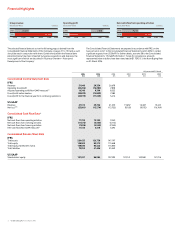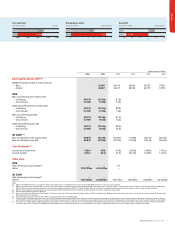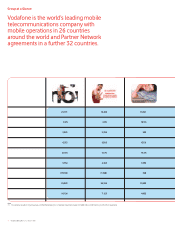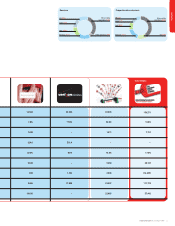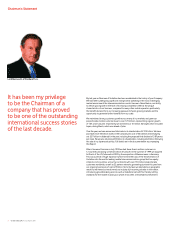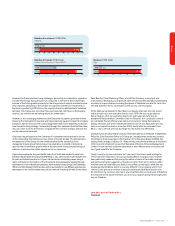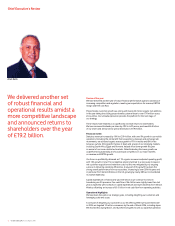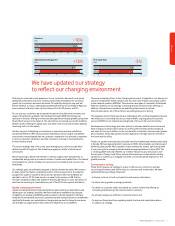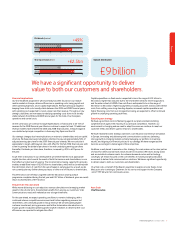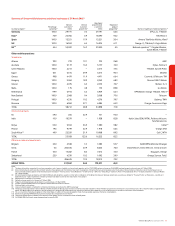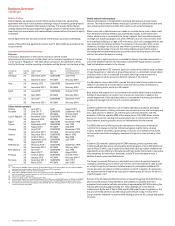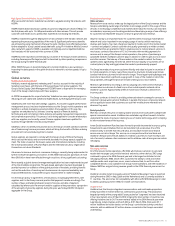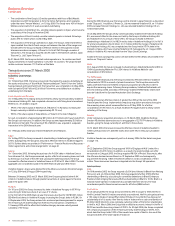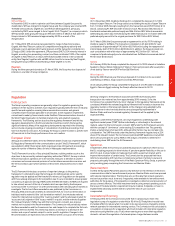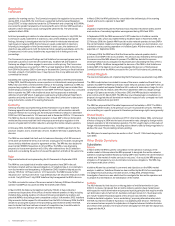Vodafone 2006 Annual Report Download - page 14
Download and view the complete annual report
Please find page 14 of the 2006 Vodafone annual report below. You can navigate through the pages in the report by either clicking on the pages listed below, or by using the keyword search tool below to find specific information within the annual report.
12 Vodafone Group Plc Annual Report 2006
Business Overview
Introduction
Vodafone Group Plc is the world’s leading mobile telecommunications company, with a
significant presence in Europe, the Middle East, Africa, Asia Pacific and the United States
through the Company’s subsidiary undertakings, joint ventures, associated undertakings
and investments.
The Group’s mobile subsidiaries and joint venture in Italy operate under the brand name
“Vodafone”. In the United States, the Group’s associated undertaking operates as Verizon
Wireless. During the last two financial years, the Group has also entered into
arrangements with a number of its associated undertakings and with network operators
in countries where the Group does not hold an equity stake. Under the terms of these
Partner Market agreements, the Group and its Partner Markets co-operate in the
development and marketing of certain services, often under dual brand logos. This has
expanded the Group’s global footprint in Europe, Asia Pacific and, most recently, South
America.
The Group provides a wide range of voice and data mobile telecommunications services,
including text messages (“SMS”), picture messages (“MMS”) and other data services, and
is continually developing and enhancing service offerings, particularly through third
generation (“3G”) mobile technology which is being deployed in the majority of the
Group’s operations. Services are provided to both consumers and corporate customers,
through a variety of both prepaid and contract tariff arrangements.
The Group’s mobile services are currently offered over a Global System for Mobile
Communications (“GSM”) network, on which a General Packet Radio Service (“GPRS”)
service is also provided and, in certain operations, over a Wideband Code Division
Multiple Access (“W-CDMA”) 3G network. The Group’s discontinued operation in Japan
operated a different technology to GSM. Where licences have been issued, the Group
has secured 3G licences in all jurisdictions in which it operates through its subsidiary
undertakings and continues to roll out mobile 3G network infrastructure. Vodafone
offered 3G services in 11 of its controlled operations at 31 March 2006.
The Group is managed and organised by business and geography. The Group has mobile
and fixed line telecommunications businesses, with the latter referred to as Other
Operations. Vodafone’s principal mobile operations are located in Germany, Italy, Spain,
the UK and the US with the Group’s Other Mobile Operations covering operations in
Europe, the Middle East, Africa and Asia Pacific. In addition, there are a number of central
functions which provide services to the mobile operations and allow the Group to
leverage its scale and scope and manage risk effectively. Other Operations principally
consists of the Group’s controlling interest in a fixed line telecommunications business
in Germany. On 1 May 2006, changes to the organisational structure were effected with
the objective of focusing the Group’s mobile businesses according to different market
and customer requirements.
The Company’s ordinary shares are listed on the London Stock Exchange and the
Company’s ADSs are listed on the New York Stock Exchange (“NYSE”). The Company had
a total market capitalisation of approximately £72 billion at 26 May 2006, making it the
fifth largest company in the Financial Times Stock Exchange 100 index and the twenty
second largest company in the world based on market capitalisation at that date.
Mobile Telecommunications
Local operations
The Company has equity interests in 26 countries, through its subsidiary undertakings,
joint ventures, associated undertakings and investments. Partner Market arrangements
extend the Group’s footprint to a further 32 countries.
At 31 March 2006, based on the registered customers of mobile telecommunications
ventures in which it had equity interests at that date, the Group had approximately 170.6
million customers, calculated on a proportionate basis in accordance with the Group’s
percentage interest in these ventures, and 518.0 million registered venture customers.
The table on the following page sets out a summary of the Company’s worldwide mobile
operations at 31 March 2006 and venture customer growth in the year then ended (the
“2006 financial year”).
Competition
The Group faces a high degree of competition in each of its geographic markets. It is
subject to indirect competition from providers of other telecommunications services in
the domestic markets in which it operates in addition to direct competition from existing
mobile telecommunications network operators and MVNOs who do not operate a
mobile telecommunications network. There are also new types of competitors, such as
fixed line operators offering combined fixed and mobile service offerings, and internet
based companies extending their services to include telecommunications. Competitive
pressures have adversely impacted the level of customer churn, although this has been
managed by reductions in tariffs and a continued focus on customer acquisition and
retention initiatives.
The Group expects that competition will continue from existing operators as well as from
a number of new market entrants, including those arising following the award of new 3G
licences and MVNOs. The scope of this increased competition, and the impact on the
results of operations, is discussed further in “Performance – Risk Factors, Trends and
Outlook”.
Many of Vodafone’s key markets are highly penetrated with over 100% penetration rates
in some, largely due to a number of customers owning more than one subscriber
identity module (“SIM”), which is, broadly, the Group’s basis for defining a customer. The
Group has estimated penetration rates at 31 December 2005 for its principal markets as
follows:
Market Penetration (%)
Germany 96
Italy 122
Spain 98
UK 109
US 69
A summary of the significant mobile competitors in its markets at 31 March 2006 is also
provided in the following table.
Contents
Page
Business Overview 12
– Introduction 12
– Mobile Telecommunications 12
– Non-mobile Telecommunications 19
– History and Development of the Company 19
Regulation 21


